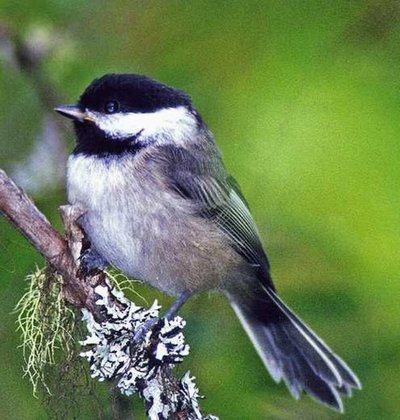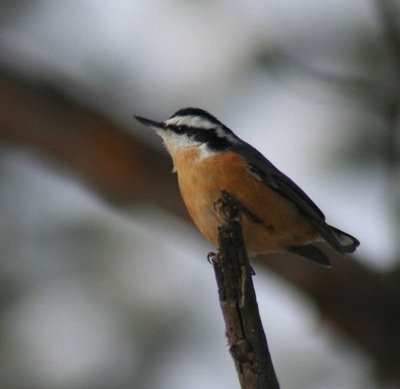March 19, 2007
Eavesdropping nuthatches distinguish danger threats in chickadee alarm calls
If Dr. John Watson had been chronicling the work of Christopher Templeton rather than the exploits of Sherlock Holmes, he might have entitled the latest research by Templeton “The Adventure of the Avian Eavesdroppers.”
The University of Washington doctoral student has found the first example of an animal making sophisticated decisions about the danger posed by a predator from the information contained in the alarm calls of another species.
In a paper published this week in the on-line edition of the Proceedings of the National Academy of Sciences, Templeton reports that red-breasted nuthatches (Sitta Canadensis) eavesdrop on the alarm calls of the black-capped chickadee to glean information about predators in their environment. Two years ago, Templeton showed that the chickadees’ (Poecile atricapillus) familiar chick-a-dee-dee-dee alarm calls contained a surprising amount of information. Now, it turns out, the nuthatches can understand the warnings given by the chickadee.
“No one has ever seen this behavior before. There are a fair number of animals that respond to other animal’s alarm calls. But this is the first example of subtle information from a call being interpreted by another species,” said Templeton. “Nuthatches can tell if a raptor poses a high or low danger from the chickadee’s alarm call.”
His earlier work showed that the chickadees had two types of alarm calls to warn about predators. When they see flying raptors — birds of prey such as hawks, owls and falcons — they issue a soft, high-pitched “seet” call. However, when they see a stationary or perched predator, chickadees use a loud, wide-spectrum chick-a-dee-dee-dee alarm to recruit other birds to harass, or mob, the predator and chase it away.
Analysis of recorded chickadee mobbing calls indicated that the acoustic features of the calls varied with the size of the predator observed. Most typically chickadees change the dee-dee-dee note at the end of the calls, sometimes adding five, 10 or 15 dees. When the recordings were played back to other chickadees their response was related to the size and threat presented by the potential predator. Small, agile raptors such as the pygmy owl which can prey on small songbirds present a greater danger to the chickadees than does the great horned owl, a larger, less maneuverable raptor.
Chickadees and nuthatches are similar in size, occupy many of the same habitats, exist in mix-species flocks during the winter and are attacked by the same predators. To see if and how nuthatches responded to the chickadee alarm calls, Templeton placed a speaker at the base of trees in a forest where pairs of the nuthatches were present. He observed their behavior when he played chickadee calls warning about pygmy and great horned owls. All trials were conducted when no live chickadee were present so their behavior wouldn’t influence the nuthatches.
The nuthatches exhibited strong mobbing behavior — more of them responded, flew closer to the speaker and appeared to be more agitated by flicking their wings when they heard the small predator alarm than when they heard the large owl alarm.
“It turns out that these animals are pretty smart,” said Templeton. “Knowing what kinds of predators are around could be a matter of life or death for them, so it pays for them to listen to the alarm calls of other species. That one animal has cracked the code and extracted the information from another species is pretty amazing.”
He said this appears to be learned behavior because the mobbing calls of the two songbird species are very different.
“Mobbing seems to be a way of teaching birds which predators are dangerous. But we have no idea how nuthatches learn to interpret the chickadee calls.”
Co-author of the paper is Erick Greene, an associate professor of biological sciences at the University of Montana. The research was funded in part by a National Institutes of Health auditory neuroscience training grant.
###
For more information, contact Templeton at (206) 523-1277 or ctemple2@u.washington.edu




